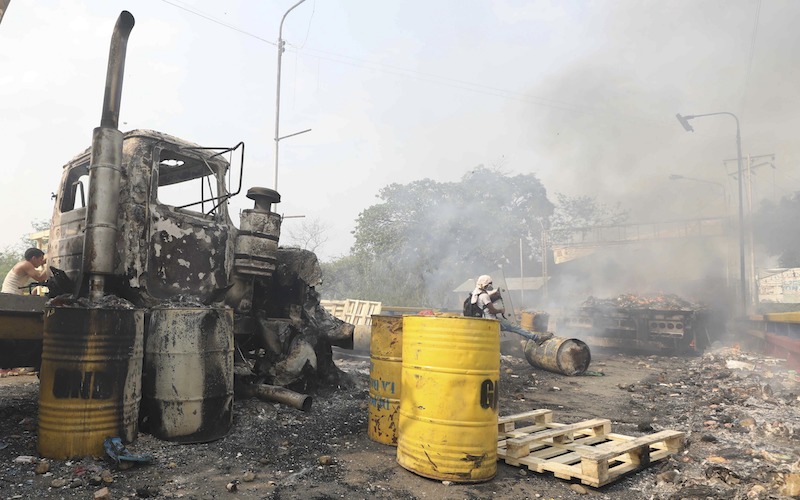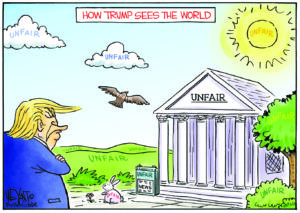Will the Corporate Media Retract Its Venezuela Lies?
While independent journalists were skeptical, mainstream news outlets repeated claims that have been disproved. Charred trucks on the Francisco de Paula Santander International Bridge at the Colombia-Venezuela border Saturday. (Fernando Vergara / AP)
Charred trucks on the Francisco de Paula Santander International Bridge at the Colombia-Venezuela border Saturday. (Fernando Vergara / AP)
The New York Times published a video on Saturday that disproves reporting by the U.S. establishment media that Venezuelan President Nicolás Maduro’s forces had set ablaze trucks filled with humanitarian aid. While U.S. officials and media parroted the story as a provocation of war, some independent journalists have argued for weeks that the story was false.
The claim that Maduro had burned aid on the Francisco de Paula Santander International Bridge on Feb. 23 was repeated and used as a way to catalyze support for further U.S. involvement in Venezuela. More politicians began to speak out in support of regime change. And as national security adviser John Bolton made clear, the U.S. is interested in Venezuela’s oil.
“U.S. news stars and think tank luminaries who lack even a single critical brain cell when it comes to war-provoking claims from U.S. officials took a leading role in beating the war drums without spending even a single second to ask whether what they were being told were true,” wrote Glenn Greenwald at The Intercept.
The detailed video published by The New York Times aligns with an earlier independent report. On Feb. 24, the day after the fire, The Grayzone’s Max Blumenthal used several photographs and videos to show a “total lack of evidence of Venezuelan culpability.” The Times has now reported that opposition protesters accidentally lit a truck on fire with a Molotov cocktail.
Blumenthal rebutted the claim that Venezuelan forces had started the fire with tear gas: “I have personally witnessed tear gas canisters hit every kind of vehicle imaginable in the occupied Palestinian West Bank,” he wrote, “and I have never seen a fire like the one that erupted on the Santander bridge.”
At the same time, mainstream news outlets spread the lies. CNN reported that some of their journalists “saw incendiary devices from police on the Venezuelan side of the border ignite the trucks.” One of the reporters who worked on Saturday’s Times story, Nick Casey, tweeted on Feb. 24: “I think the more simple explanation is the right one: The oppo threw the rocks and the govt burned the trucks.”
The NY Times confirms my @GrayzoneProject reporting on the Venezuelan opposition burning US aid trucks & shows how everyone from @marcorubio to @AmbJohnBolton lied about it.
Read @ggreenwald on the twisted deception. (Unlike NYT, Glenn cited our work)https://t.co/SAU5CGnKnS
— Max Blumenthal (@MaxBlumenthal) March 10, 2019
Greenwald pointed out that in the hours following the incident, other people “who use their brains to critically evaluate what the U.S. Government says when it’s trying to start a new war, rather than mindlessly recite those claims as Truth, as U.S. media stars do—used the exact same evidence cited by the NYT last night to show that it was anti-Maduro protesters, not Maduro troops, who set the trucks on fire.”
It’s also useful to consider what was at stake in the incident. The bigger picture here is that humanitarian aid—said to help a country put into poverty in part by U.S. sanctions—is a tool for military intervention. Last month, Adam Johnson explained for Truthdig how U.S. weapons have been disguised previously:
Your support matters…Since the Spanish-American War, the U.S. has used humanitarian concerns as a shield against criticism or skepticism, and it has more or less worked every time. It’s why “aid” organizations like Air America used food transports to ship guns to anti-Communists in Indochina in the 1960s and ’70s. (Weapons were code-named “hard rice.”) And it’s why Elliott Abrams—the current quarterback of this latest affair in Venezuela—used humanitarian aid shipments to smuggle weapons to Nicaragua’s Contras in the ’80s. Ultimately, these shipments allow for massive military buildups, without anyone in the media or Congress asking too many questions. After all, what kind of monster is opposed to helping starving people?
It’s impossible to know if the current shipments to Venezuela are being used to transport weapons, although Venezuelan authorities say they have intercepted American arms shipments. But given the history of the U.S. (to say nothing of Abrams’), and the fact that the Trump administration is openly calling for Maduro’s ouster while amassing forces along the Colombian border, it’s not exactly a long shot. Still, our political press dismisses the possibility as tin-foil hat stuff, at least in part because mocking wacky Latin American ‘conspiracy theories’ is a mark of one’s seriousness in foreign policy circles.
Independent journalism is under threat and overshadowed by heavily funded mainstream media.
You can help level the playing field. Become a member.
Your tax-deductible contribution keeps us digging beneath the headlines to give you thought-provoking, investigative reporting and analysis that unearths what's really happening- without compromise.
Give today to support our courageous, independent journalists.






You need to be a supporter to comment.
There are currently no responses to this article.
Be the first to respond.